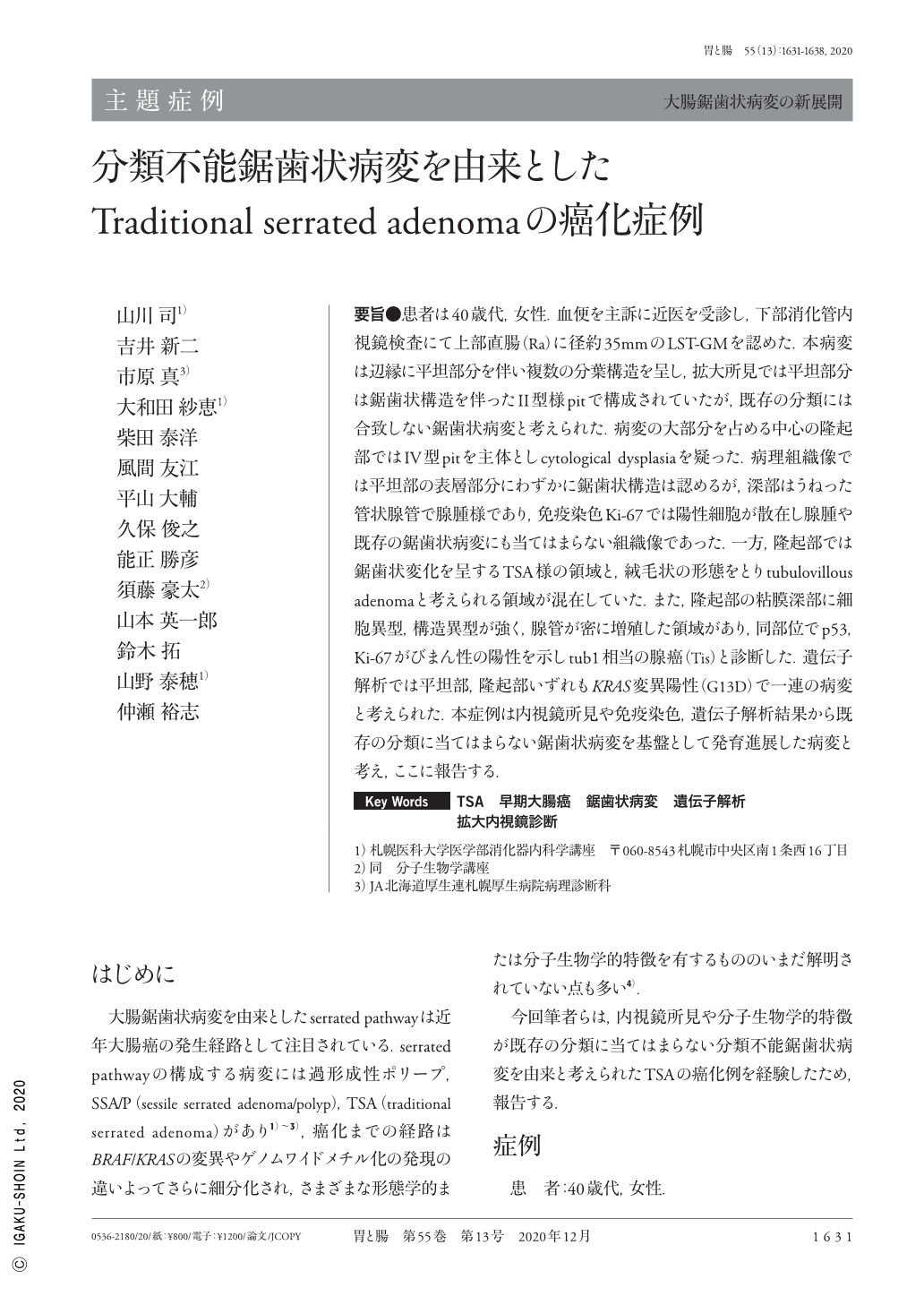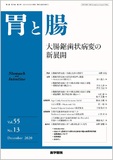Japanese
English
- 有料閲覧
- Abstract 文献概要
- 1ページ目 Look Inside
- 参考文献 Reference
要旨●患者は40歳代,女性.血便を主訴に近医を受診し,下部消化管内視鏡検査にて上部直腸(Ra)に径約35mmのLST-GMを認めた.本病変は辺縁に平坦部分を伴い複数の分葉構造を呈し,拡大所見では平坦部分は鋸歯状構造を伴ったII型様pitで構成されていたが,既存の分類には合致しない鋸歯状病変と考えられた.病変の大部分を占める中心の隆起部ではIV型pitを主体としcytological dysplasiaを疑った.病理組織像では平坦部の表層部分にわずかに鋸歯状構造は認めるが,深部はうねった管状腺管で腺腫様であり,免疫染色Ki-67では陽性細胞が散在し腺腫や既存の鋸歯状病変にも当てはまらない組織像であった.一方,隆起部では鋸歯状変化を呈するTSA様の領域と,絨毛状の形態をとりtubulovillous adenomaと考えられる領域が混在していた.また,隆起部の粘膜深部に細胞異型,構造異型が強く,腺管が密に増殖した領域があり,同部位でp53,Ki-67がびまん性の陽性を示しtub1相当の腺癌(Tis)と診断した.遺伝子解析では平坦部,隆起部いずれもKRAS変異陽性(G13D)で一連の病変と考えられた.本症例は内視鏡所見や免疫染色,遺伝子解析結果から既存の分類に当てはまらない鋸歯状病変を基盤として発育進展した病変と考え,ここに報告する.
The patient was a female in her 40s who visited a local doctor with a chief complaint of bloody stools, and lower gastrointestinal endoscopy confirmed Granular Mixed Laterally Spreading Tumors(LST-GM)with a diameter of approximately 35mm in the rectum/above the peritoneal reflection(Ra). This lesion exhibited multiple lobular structures with a flat part at the edge, and magnified imaging showed that the flat part comprised of type II-like pits with a serrated structure, but it was believed to be a serrated lesion that did not match the existing classification. The protrusion at the center that occupied a large part of the lesion mainly comprised of type IV pits, and cytological dysplasia was suspected.
Histopathologically, the serrated structure was slightly confirmed on the surface of the flat part, but the deep part was adenomatous due to undulated tubular glands. However, by immunostaining Ki-67, tissue images showed that positive cells were scattered, and they did not match adenomas and the existing serrated lesion. Conversely, TSA-like regions exhibiting serrated changes, and regions believed to be tubulovillous adenoma with a villous morphology were mixed at the protrusion. Additionally, at the depth of the mucosa of the protrusion, there was a region where glandular ducts with advanced cellular atypia and structural atypia were densely proliferated, p53 and Ki-67 showed diffuse positivity at the same site, and adenocarcinoma(Tis)equivalent to tub1 was diagnosed. On genetic analysis, both the flat part and the protrusion were KRAS mutation positive(G13D), and they were believed to be a series of lesions. In this study, we hereby report this case of a patient who was believed to be suffering from a lesion that had grown and progressed based on the serrated lesion that did not match the existing classified and also based on the endoscopic findings, immunostaining, and genetic analysis results.

Copyright © 2020, Igaku-Shoin Ltd. All rights reserved.


